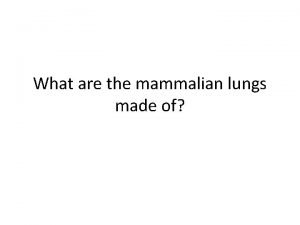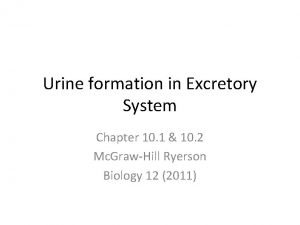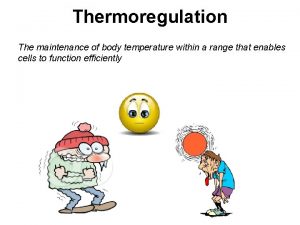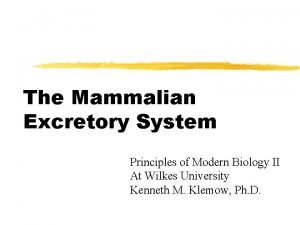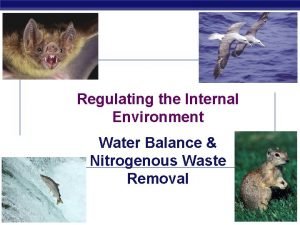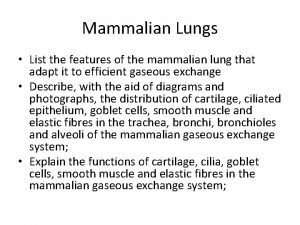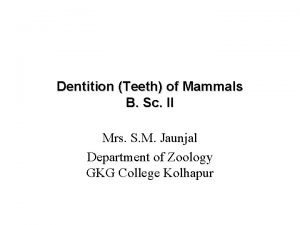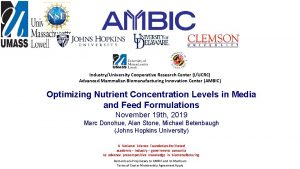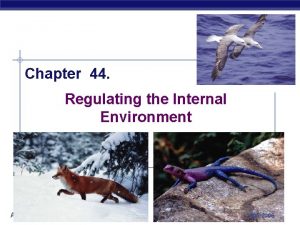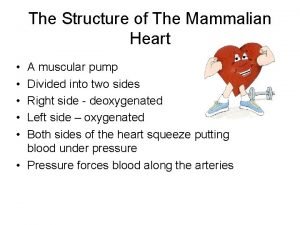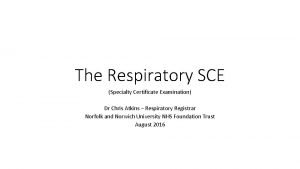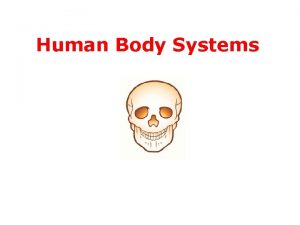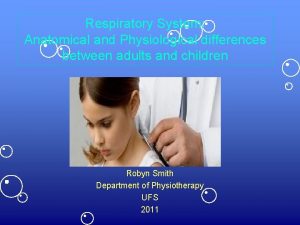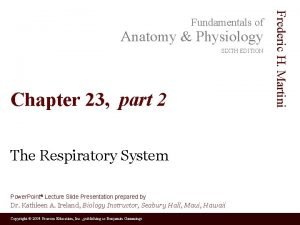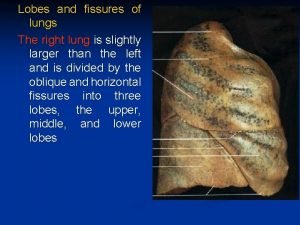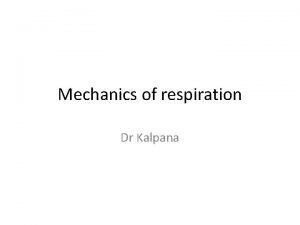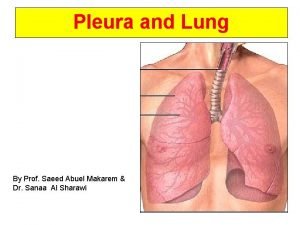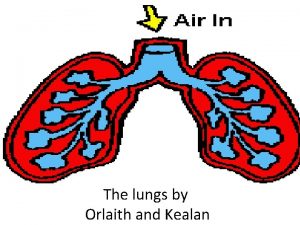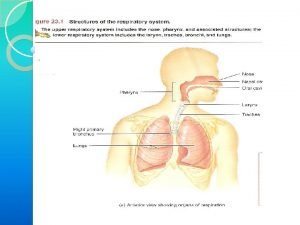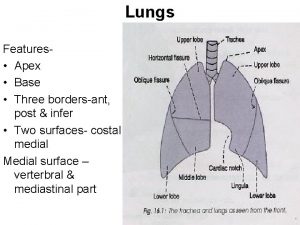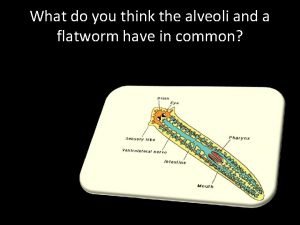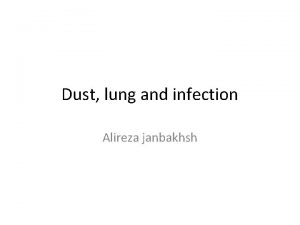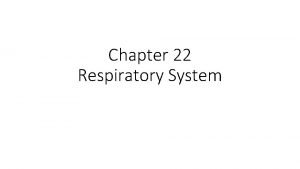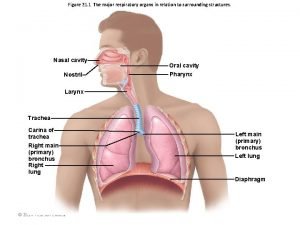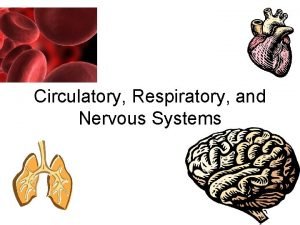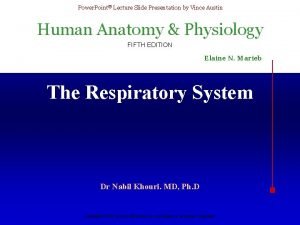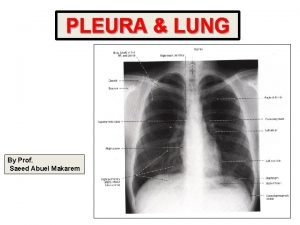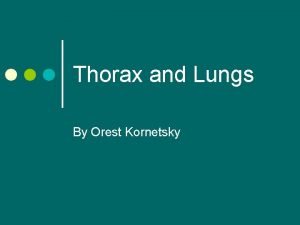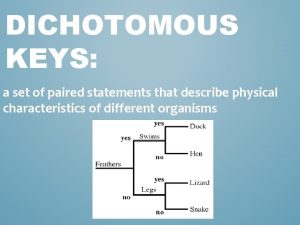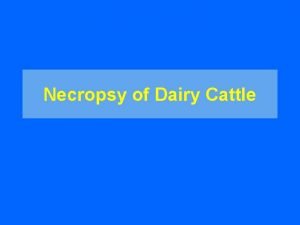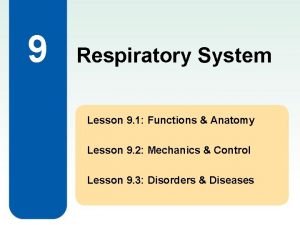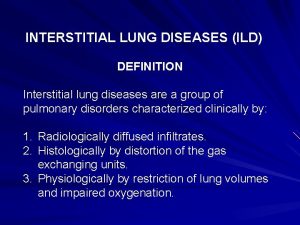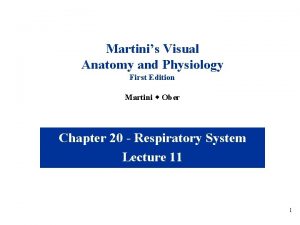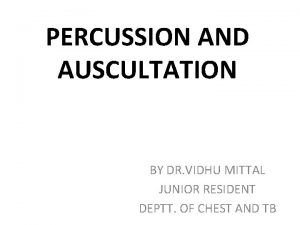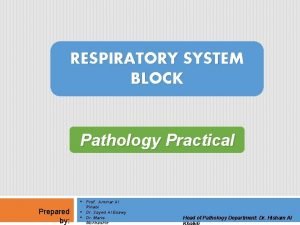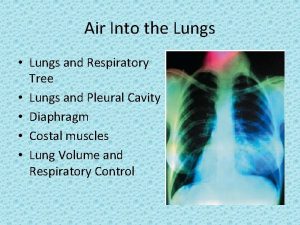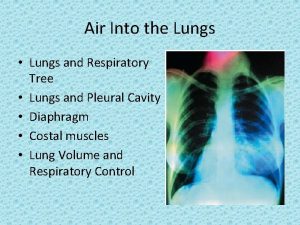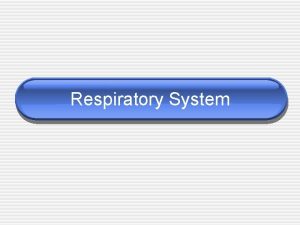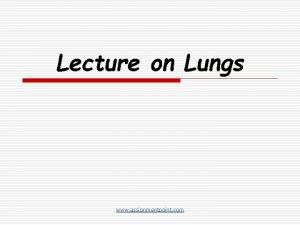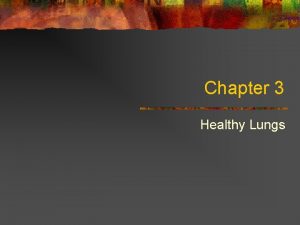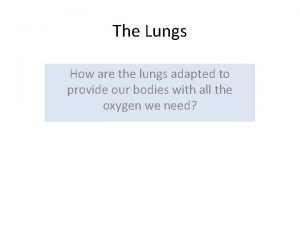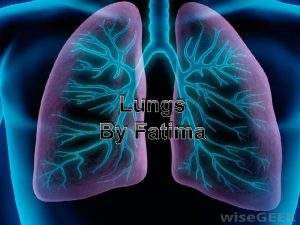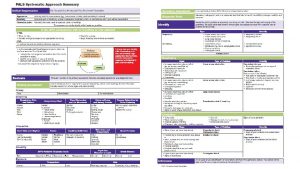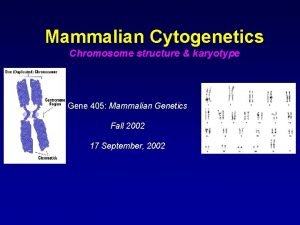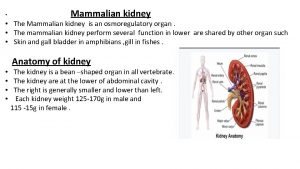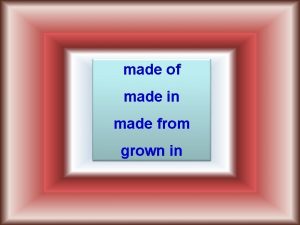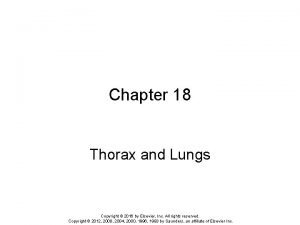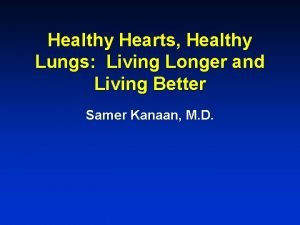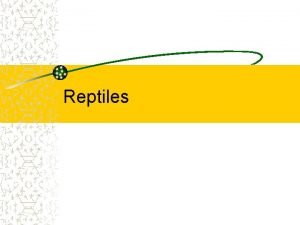What are the mammalian lungs made of Success










































- Slides: 42

What are the mammalian lungs made of?

Success Criteria • Describe, with the aid of diagrams and photographs, the distribution of cartilage, ciliated epithelium, goblet cells, smooth muscle and elastic fibres in the trachea, bronchioles and alveoli of the mammalian gaseous exchange system; • Explain the functions of cartilage, cilia, goblet cells, smooth muscle and elastic fibres in the mammalian gaseous exchange system;

Starter- Structure of the thorax Put them in the correct order Nose Terminal bronchioles Secondary bronchi Alveoli, alveolar ducts and alveolar air sacs. Right and left primary bronchi Tertiary bronchi Trachea

The structure of the thorax Nose Trachea / Windpipe, Right and left primary bronchi Secondary bronchi, Tertiary bronchi Terminal bronchioles Alveoli, alveolar ducts and alveolar air sacs.

O 2 from the atmospheric air entering the alveoli enters the blood by diffusion across the alveolar wall down its concentration gradient Total barrier to diffusion is less than 1 um CO 2 from the blood enters the alveoli by diffusion across the alveolar wall down its concentration gradient

Tissues 1 – the alveoli Alveoli – spherical and numerous (600 million); 100300 um across – giving a large surface area of approx. 80 -100 m 2 for rapid gas exchange between the blood and atmosphere; Oxygenated blood to heart via pulmonary vein Low CO 2 concentration Deoxygenated blood from heart via pulmonary artery High CO 2 concentration Direction of blood flow

Tissue 2 – capillaries Plasma – carries CO 2 in different forms • Capillaries are numerous and tubular in close contact with alveoli - wall also made of squamous epithelium and one cell thick; total diffusion distance is less than 1 um Capillaries are narrow – red blood cells squeeze against the capillary wall – making contact with the wall to reduce diffusion distance. The blood cells are also slowed down – increasing the time for exchange RBC’s – contain haemoglobin - carries O 2 as oxyhaemoglobin Alveolus wall Capillary wall Each one cell thick

Features of the alveoli • Surfactant produced by alveoli – reduces cohesive surface tension forces between H 2 O molecules in film of H 2 O • ST forces may cause collapse of alveoli during exhalation – prevented by surfactant • Diffusion gradient maintained by rhythmic ventilation (replaces air in alveoli) and a rich blood supply – Capillaries –standard features of good gas exchange surface Close contact with alveolar wall 1 cell thick – short diffusion distance Narrow – space enough for passage of single RBC – allows close contact with capillary wall • Large surface area – numerous and tubular • •

How do these adaptations assist with gas exchange? Hairs Mucus – Blood in capillaries in nose – Constant ventilation – Haemoglobin – Moist surface area – Rich blood supply to alveoli – Surfactant Presence of phagocytes in alveoli -

Adaptations of Respiratory System for Gas Exchange • Cleans, warms, and moistens the air entering the respiratory tract– achieved by hairs, mucus, and blood capillaries (warm blood) in the nasal cavity and cilia in the trachea • Constant ventilation - replacing the air in the alveoli to maintain a concentration gradient between the alveolar air and the blood • Alveoli are surrounded by a large number of capillaries – a rich blood supply, replaces the blood constantly, to maintain a concentration gradient between the blood and alveolar air. • Haemoglobin (Hb) in red blood cells carries oxygen and has a high affinity for oxygen – helps in maintaining a steep concentration gradient for oxygen • Moist exchange surface – allows gases to dissolve • Water in the alveoli contains a surfactant (phospholipid) – reduces surface tension – prevents collapse of alveoli • Alveoli contain phagocytic cells - for defence

GAS EXCHANGE . . . describe with the aid of diagrams and photographs, the distribution of cartilage, ciliated epithelium, goblet cells, smooth muscle and elastic fibres in the trachea, bronchioles and alveoli of the mammalian gaseous exchange system Rings of cartilage in the walls of the trachea and bronchi provide support It is strong but flexible It stops the trachea and bronchi collapsing when pressure drops

Structural components of the respiratory system Trachea Smooth muscle Contracts and relax to allow diameter of airways to be controlled. During exercise the muscle relaxes – making the airways wider – reduces resistance to air flow – aids ventilation Muscles contracts to narrow the airways when challenged with foreign material (e. g. pollen) to protect airways and alveoli Elastic fibres Stretch to allow expansion during inhalation and recoil during exhalation; prevent over expansion C-shaped rings of cartilage Provide structural support Prevent collapse of airway during inhalation Allows flexibility during movement without narrowing of airways Allows oesophagus to expand during swallowing

Compare the role of the smooth muscle and elastic fibres in the trachea (6)

Tissue 3 - Smooth muscle and elastic fibres in the trachea Smooth muscle is found in the walls of the trachea, bronchi and bronchioles Smooth muscle relaxes during exercise, widening the lumen Results in less resistance to airflow Elastic fibres stretch on inspiration and recoil to help push air out when exhaling

Tissue 4 – cartilage Structure Cartilage Function/Characteristics Supports trachea and bronchi. Prevents it from collapsing when air pressure is low. Some flexibility to move neck. Allows oesophagus to expand during swallowing.

Tissue 5 - Ciliated epithelium Simple columnar epithelial cells Fine hair-like outgrowths Rapid, rhythmic, wavelike beatings Movement of mucus Usually found in the air passages like the nose, uterus and fallopian tubes

Ciliated epithelium Cilia beat the mucus Helps to prevent lung infections

Goblet cells Specialised as gland cells Synthesising and secreting mucus

Tissue 6 - Goblet cells Secrete mucus Mucus traps microorganisms and dust particles in inhaled air

Structural components of the respiratory system Inside surface of trachea – epithelial lining Goblet (mucus) cells Secrete mucus – traps particles (e. g. dust, pollen, bacteria) – reduce risk of infection & inflammation Ciliated epithelium Cilia beat in a synchronised pattern to move (waft) mucus (with particles) towards throat – to be swallowed (stomach acid kills bacteria) or expectorated; prevents infection Cells contain numerous mitochondria (energy for ciliary movement) Loose tissue Inside surface of cartilage – glandular tissue, connective tissue, elastic fibres, smooth muscle and blood vessels

Cross section of bronchiole Alveolus wall § Thin - single cell thick § Squamous epithelium § Reduces diffusion distance Bronchiole wall § Ciliated epithelium (cilia move mucus upwards) § Goblet cells (secrete mucus) Blood capillary § Close to alveoli § Thin - single cell thick § Squamous epithelium § Reduces diffusion distance Pulmonary vein § Carries oxygenated blood to heart

(a) Bronchiole and (b) trachea in transverse section

Structure Function/Characteristics Cartilage Smooth muscle Elastic fibres Goblet cells and glandular tissue Ciliated epithelium Bronchioles .

Structure Function/Characteristics Cartilage Supports trachea and bronchi. Prevents it from collapsing when air pressure is low. Some flexibility to move neck. Allows oesophagus to expand during swallowing. Smooth muscle Allow contraction and makes lumen of the airway narrower. Restricts harmful substances in the air. Not voluntary and causes asthma. Elastic fibres Reduces diameter of the lumen when smooth muscle contracts. Dilates when smooth muscle relaxes, fibres recoil to original shape. Goblet cells and glandular tissue Ciliated epithelium Found under the epithelium and secretes mucus to trap tiny particles e. g pollen and bacteria. Reduces risk of infection. Contains cilia, cells with tiny hairs Bronchi Have plates of cartilage in their walls, together with elastic tissue and a mucus-secreting ciliated epithelium. Bronchioles No cartilage and the epithelium is simple. No cilia or goblet cells

Small intestine (absorption of nutrients) Liver (Sugar levels adjusted) Examples of specialised exchange surfaces Root hair of plants (water and minerals absorbed) Hyphae of fungi (nutrients absorbed)

Practical: Make annotated diagrams of lung tissue Objectives • To use a light microscope to examine slides of lung tissue • To make annotated diagrams of trachea, alveolar cells and blood vessels

1) Use the light microscope to make an annotated diagram of the trachea/ lung tissue. 2) Look at the diagrams below. Draw a table to describe the function and characteristics for each part. (a) Bronchiole and (b) trachea in transverse section

Exam Question 4. The diagram below shows the detailed structure of a small part of the mammalian lung. (i) State the name of the structure shown between lines D and E. . . . . . . . [1] alveolus/alveolar air, sac/space; A alveoli/air sac A squamous epithelium 1

Exam Question List three features of the structure which you have identified in (i) which make it suitable for gas exchange. 1. . . . . . . . . . . . . . . 2. . . . . . . . . . . . . . . large surface area to volume (ratio)/AW; R large area unqualified 3. . . . . . . . thin/one cell thick, wall/short diffusion distance/AW; . . . . . . . A appropriate figures for width [3] [Total 4 marks] squamous epithelium; permeable; blood supply, qualified; elastic tissue/recoil (after expansion); surfactant; 3 max

Exam Question 5. The different parts of the gaseous exchange system, such as the bronchi, show structural adaptations to their functions. The diagram below shows a section through the wall of a bronchus as seen with a light microscope.

Exam Question (a)(i)State one function for each of the following components of the bronchus wall. goblet cell. . . . . . produce / secrete / release, mucus; . . . . . . . prevent collapse of / hold open / support, airways; cartilage. . . . . . A provide shape of bronchus. . . . . . . R gives wall, structure / strength [2] (ii)State two ways in which the structure of the wall of the bronchus would be different in a long-term smoker. cilia, destroyed / damaged; R cilia not working 1. . . . . . . (epithelium replaced by) scar tissue / scarring; . . . . . . . (smooth) muscle becomes thicker; 2. . . . . . . mucous glands enlarge / larger goblet cells / more goblet cells; . . . . . . . R more mucus secreted [2] inflammation of connective tissue; AVP; idea of tumour if it describes a structural change

Exam Question (b) Gaseous exchange occurs across the walls of the alveoli. Explain why the walls of the alveoli contain elastic fibres. . . . . . . . stretch, as air is inhaled / allow alveoli to expand during inhalation; . . . . . . . to increase lung volume / surface area; . . . . . . . prevents alveoli bursting; . . . . . . . (elastic fibres) recoil, as exhale; R contract [2] more, complete / rapid, expulsion (from the alveoli); A expel more air

Exam Question (c) One feature of the disease emphysema is that the alveoli lose their elasticity. Explain the effects of this loss of elasticity on the gaseous exchange system of a person with emphysema. tidal volume is reduced / less air inhaled and exhaled / residual. . . . . . . . volume is larger / air trapped in alveoli / vital capacity smaller; . . . . . . . more difficult to exhale; . . . . . . . (as) alveoli cannot, stretch / recoil; . . . . . . . rapid / shallow, breathing / breathlessness / wheezing; . . . . . . . alveoli may burst; . . . . . . . leaves gaps in tissue / larger air spaces / AW; . . . . . . . less surface area (for gaseous exchange); . . . . . . . blood / haemoglobin, less well oxygenated / less carbon dioxide [4] removed; [Total 10 marks] R less able to do exercise / need to use oxygen max 4

Ventilation The ribcage, intercostal muscles and diaphragm all work together to move air into and out of the lungs, where gas exchange occurs across the thin (single-celled) walls of the alveoli Ventilation is a physical process, relying on the principle of Boyle’s Law – which state “Pressure is inversely proportional to volume” The mechanism can be illustrated using a bell jar model of the respiratory system – however, the model does not illustrate involvement of the rib cage and the intercostal muscles in ventilation Breathing out (expiration / exhalation) Internal intecostals contract in forced expiration Breathing in (inspiration / inhalation)

INSPIRATION EXPIRATION Atmospheric pressure = 760 mm. Hg Diaphragm & external intercostals contract Rib cage raised (upwards and outwards) Diaphragm lowered (becomes flatter) Volume of chest cavity increases Pressure in chest cavity drops to below atmospheric pressure to 758 mm. Hg Diaphragm & external intercostals relax Rib cage lowered Diaphragm raised (dome shape) due to push from abdominal organs Volume of chest cavity decreases Pressure in chest cavity increases to above atmospheric pressure to 763 mm. Hg Air moves into lungs from atmosphere Active process Air forced out of lungs into atmosphere Aided by elastic recoil and abdominal organs Passive process


Inhaling (Inspiration) Exhaling (Expiration) Volume of thorax Diaphragm muscle Diaphragm Relaxes and resumes to dome shape External intercostal muscles Rib cage Pressure in chest cavity Movement of air Decreases below atmospheric pressure

Inhaling (Inspiration) Exhaling (Expiration) Volume of thorax Increases Decreases Diaphragm muscle Contracts Relaxes Diaphragm Flattens and pushes digestive organs down Relaxes and resumes to dome shape External intercostal muscles Contracts/expands Relaxes Rib cage Upward and outward Inward and downward Pressure in chest cavity Decreases below atmospheric pressure Increases below atmospheric pressure Movement of air Into the lungs down pressure gradient Air forced out of lungs

Exam question (5 marks)


Exam Questions - OCR Name five tissues, cells or cell structures found in the mammalian gas exchange system and explain the function of each [5 marks]

Name five tissues, cells or cell structures found in the mammalian gas exchange system and explain the function of each [5 marks] -Goblet cells secrete mucus, the mucus traps bacteria and dust particles -Some cells are ciliated, cilia move mucus towards the throat to be removed -Elastic fibres stretch on inspiration and recoil at expiration -Smooth muscle relaxes to make air passages wider when exercising -Cartilage provides support and keeps trachea open
 Characteristic of trachea
Characteristic of trachea Mikael ferm
Mikael ferm Your child's success or lack of success
Your child's success or lack of success Your child's success or lack of success
Your child's success or lack of success Mammalian excretory system
Mammalian excretory system Maintenance of body temperature
Maintenance of body temperature Ekskresi
Ekskresi Mammalian excretory system
Mammalian excretory system Mammalian lung
Mammalian lung Dental formula in mammals
Dental formula in mammals Mammalian biomanufacturing
Mammalian biomanufacturing Glycolyaia
Glycolyaia Chapter 30 section 1 mammalian characteristics answer key
Chapter 30 section 1 mammalian characteristics answer key Mammalian excretory system
Mammalian excretory system Mammalian heart diagram
Mammalian heart diagram Sce in respiratory medicine
Sce in respiratory medicine Double layered protective membrane of lungs
Double layered protective membrane of lungs Smoking damages your lungs
Smoking damages your lungs Closing volume
Closing volume Gross anatomy of the lungs
Gross anatomy of the lungs Right lung lateral view
Right lung lateral view Define lung compliance
Define lung compliance Pleura
Pleura Aesses
Aesses Gas exchange in circulatory system
Gas exchange in circulatory system Inferior albeolar nerve
Inferior albeolar nerve Lung base apex
Lung base apex Ribs lungs analogy
Ribs lungs analogy Lungs
Lungs Pharynx and larynx
Pharynx and larynx Respiratory
Respiratory Pathway of air
Pathway of air Larynopharynx
Larynopharynx Pleural adhesions
Pleural adhesions Laynx
Laynx Crackles lung sounds
Crackles lung sounds Monkey dichotomous key
Monkey dichotomous key Lungs animal
Lungs animal Lesson 9.1 the anatomy of the lungs
Lesson 9.1 the anatomy of the lungs Lungs definition
Lungs definition Tree in lung picture
Tree in lung picture Normal breath sounds description
Normal breath sounds description Dohányos tüdő
Dohányos tüdő
